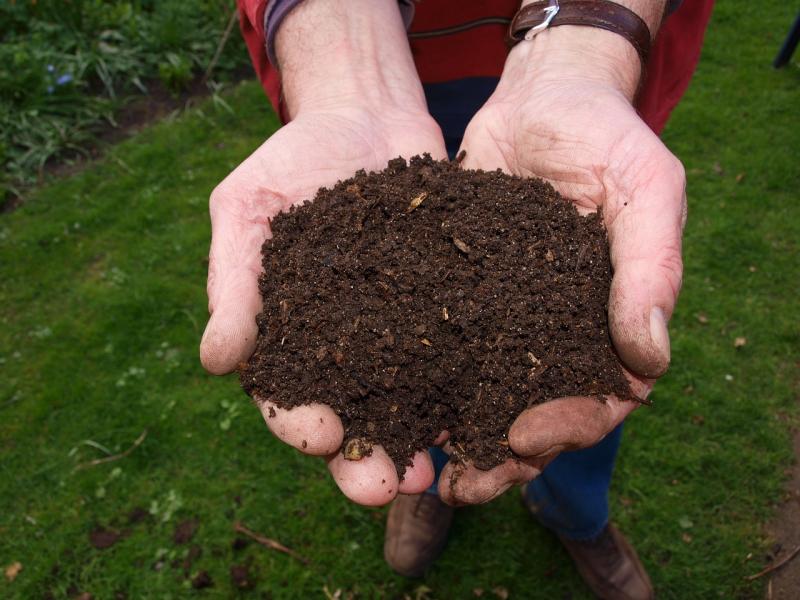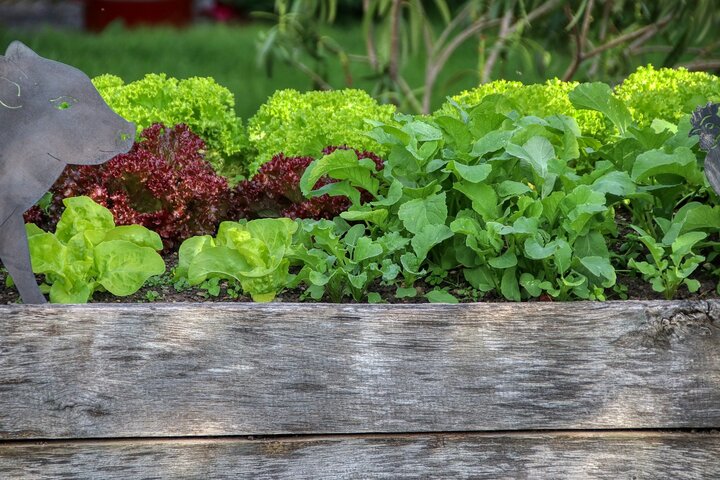Sarah Browning, Nebraska Extension Educator

Compost is a great soil amendment for improving the physical, chemical and biological properties of soils. Images from Pixabay.com.
Compost is used as a soil amendment to improve the physical, chemical and biological properties of soils. Over time, yearly additions of compost will improve your landscape or garden soil in many ways. Fall is a great time to build a compost pile. So, before your trees begin to lose their leaves this fall, consider all the great uses for compost in your landscape. Compost can be used in several ways – 1) a soil amendment, 2) a component in soil mixtures for containers or raised beds, 3) topdress fertilizer, or 4) in compost tea. No matter how you use it, compost provides many benefits for plants.

Soil Amendment with Compost
When starting a new garden or landscape, Nebraska's heavy clay soils greatly benefit from amendment before planting. It is so much easier to add compost before anything is planted, rather than after.
When new homes are built, the existing topsoil is often stripped away, removed, and not returned, so new homeowners are left with subsoil compacted by construction. Trying to grow a lawn or landscape plants in heavy compacted subsoil is difficult and can be very frustrating. It's difficult for plant roots to push their way into tight, heavy soil and plants often fail to thrive. Soil amendment with compost, worked into the underlying subsoil layer, before the final lawn or landscape is planted, creates much better soil for years to come. It’s definitely worth the extra expense and labor.
Compost is also a great amendment for sandy soil. Water percolates easily into sand, but doesn't stay long. Amending with compost increases the water holding capacity of sandy soil.
To amend bare soil, cover the area with 1 to 2 inches of compost and incorporate it by tilling the upper six inches of the soil. One cubic yard of compost will cover 325 sq. ft. at a depth of 1 inch.
Using Compost in Potting Mixes
Compost is an excellent component in soil mixes, particularly for outdoor use in containers or raised beds. Compost is an excellent component for container growing mixes, because it stores moisture effectively and provides a variety of nutrients not typically supplied in commercial fertilizers or soil-free potting mixes. To create your own soil mixture, blend screened compost with topsoil, peat moss or commercial potting mixtures.
Soil for raised beds should be light and well-drained. Before purchasing topsoil, ask for a soil test report or have the soil tested. Find a near-by soil lab. Check the pH (ideally 6-7.5), organic matter content (2-5% organic matter is recommended for landscape soils), salt and nutrient levels. If the soil's organic matter content is low, the addition of compost will raise it. Very high levels of phosphorus and potassium are normal for eastern Nebraska soils.
A soil mix of 70% topsoil and 30% compost is ideal for raised beds. Make sure the compost level stays below 40-50% of the potting mixture’s total volume. Research has shown that decreasing plant growth is found when plants are grown in potting mixes made up of more than 50% compost.
Topdress Your Lawn with Compost When used as a topdressing, a light layer of compost is broadcast over an existing lawn to promote improved soil structure, add organic matter and nutrients, and promote increased decomposition of thatch. Apply a topdressing of compost in September or after the first spring mowing, but not during the middle of summer.
When applying compost on a lawn, be sure the compost is very dry, and finely ground or sifted so there is less chance of smothering the lawn with large pieces of organic material. To finely screen compost, use a ¼-inch mesh hardware cloth instead of the ½-inch mesh used for compost mulch. To apply ½-inch of compost over your entire lawn, you will need approximately ¾ cubic yard per 1,000 sq. ft. (A 30-gallon garbage can holds about 4 cubic feet of compost.)
One way to incorporate the compost is to aerate the sod, then apply a ¼ to ½-inch layer of fine compost. Afterwards, either aerate again, or use a rake to distribute compost into the core holes. Water the lawn well.

Compost Tea
An old-fashioned way of providing liquid fertilizer for plants is to brew compost tea. Similar to manure tea, compost tea gives plants a good dose of nutrients. Compost tea works especially well for providing nutrients to new transplants and seedlings
To make compost tea fill a burlap sack or an old pillowcase with finished compost and secure the open end closed. Place the bag in a tub, barrel, or watering can filled with water. Agitate for a few minutes and then let it steep for a few days. Nutrients will leach out of the compost and the mixture will become tea-colored.
Spray or pour compost tea on and around plants. Use the bag of compost for several batches. Afterwards, simply empty the bag’s contents onto the garden. But don't use compost tea on food crops it is likely to contain food safety pathogens.
Pioneer's Park Composting Programs
Why not start a compost pile this fall? If you’d like to learn how, please join us at one of this fall’s Pioneer’s Park compost demonstrations. The demonstration site is south across the road from the Nature Center. Both programs begin at 10:00 a.m.
- September 23
- October 21
These programs are free and open to the public. Two lucky participants will win either a composting thermometer or bin. No reservation is required and anyone with an interest in composting is welcome to attend.
Images from Pixabay.com
- Compost is an excellent component in soil mixes, particularly for outdoor use in containers or raised beds.
- Don't use compost tea on food crops; it is likely to contain food safety pathogens.
Search Our Archive
Associated Video
Homemade Compost
Nebraska Extension Assistant Educator Mary Jane Frogge give some tips for making your own compost.